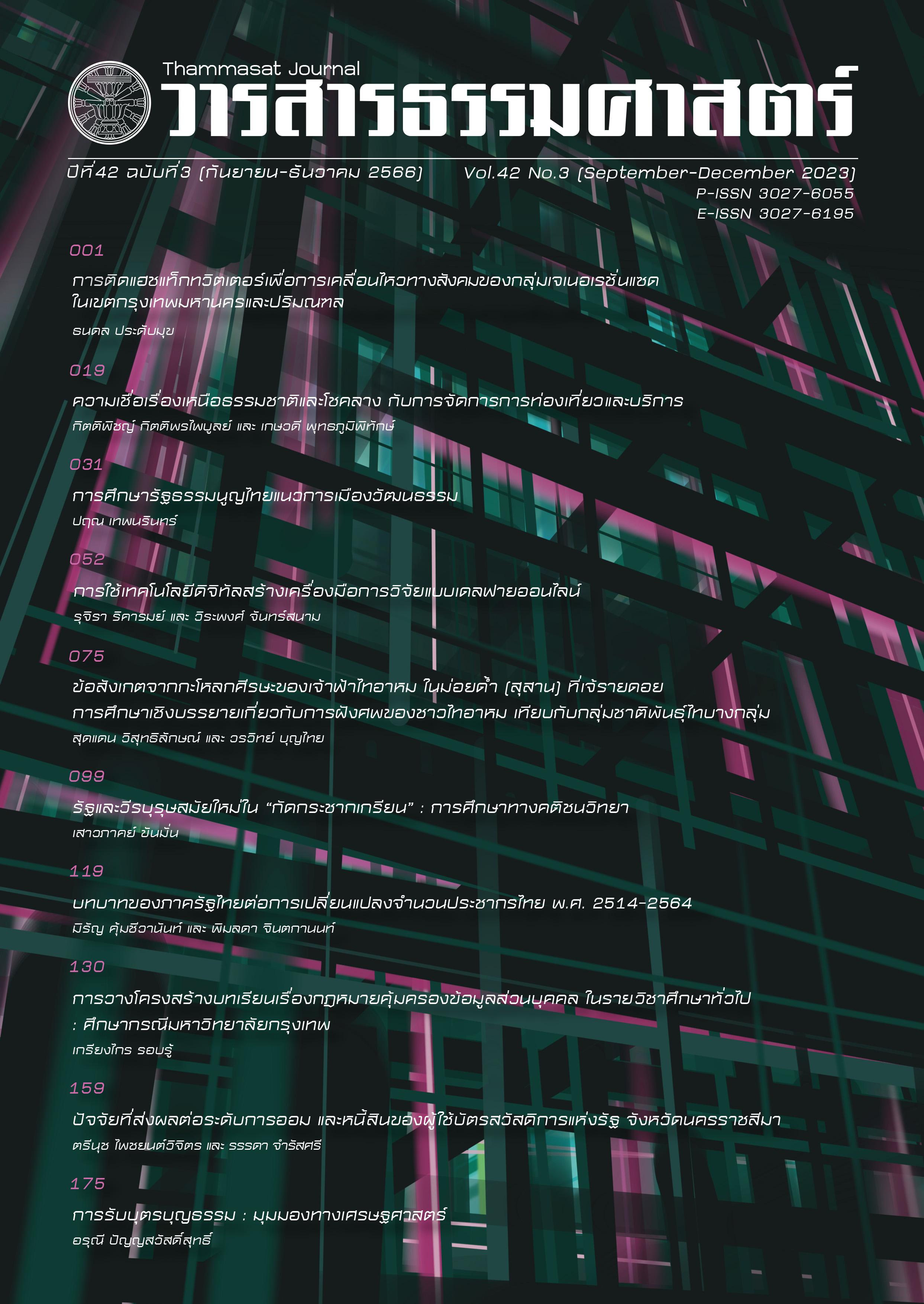An Observation of Royal Craniums from Moi-Dam in Cheraidoi A Descriptive Study of Burial Practice of Tai-Ahom and Some Other Tai Groups
Main Article Content
Abstract
In the Tai Ahom kingdom, when the king died, his body will be treated with all due ceremony and preserved in a tomb or burial pit called in Ahom language as “moi-dam” which is built up specially for him at the royal cemetery in Cheraidoi (the first capital city of Ahom kingdom). “Moi-dam” mentioned here, is the origin and main source of this research. There are three main objectives of this research work i.e. to investigate the five Ahom royal craniums excavated from moi-dam No. 2 (located in Sibsagar, Assam, India). All these skulls
show the morphological features of Asian (Mongoloid) identity. The second objective is to use an educational approach or ethnographic method for a descriptive study of the Tai-Ahom burial method based on the Ahom chronicle called Ahom Buranji together with the documentary records of western nations. It was found that there are similarities of burial tradition among the Tai ethnic although they are from different groups. And it is completely different from the Hindu traditional cremation in India. The final objective is to have further development in the field of archaeological and ethnographic research in the northeastern region of India
in the future through the cooperation with academics, research fellows etc. in various fields of this region. Morphological observations are focused on post-cranial elements. Morphological assessment of cranial and post-cranial bones is carried out following the Standards by Buikstra-Ubelakar (1994). Craniometric and osteometric methods used in this report follow Martin and Saller (1957). Stature estimation equations of Mahakkanukrauh et al. (2011). An ethno-archaeological approach is also applied with this research work for understanding the belief systems of Ahom people and other Tai groups.
Article Details
References
ฉัตรทิพย์ นาถสุภา และเรณู วิชาศิลป์. (2552). "ความเชื่อและพิธีกรรมของชาวไทอาหม: จากการอ่านอาหม-บุราณจี ภาษาไท" หน้า 27-55 ใน การศึกษาประวัติศาสตร์ไทอาหม. กรุงเทพฯ :สำนักพิมพ์สร้างสรรค์ จำกัด
บรรจบ พันธุเมธา. (2530). "อาหม". วารสารราชบัณฑิตยสถาน, 13(1). ตุลาคม-ธันวาคม 2530), 70-80
ประเสริฐ ณ นคร. ศาสตราจารย์ ดร. (2534). พจนานุกรม ไทยอาหม-ไทย. กรุงเทพฯ : พิฆเณศ พริ้นติ้ง เซ็นเตอร์ จำกัด
รวิวรรณ โอฬารรัตน์มณี และคณะ. (2559). บ้านเรือน ตัวตน คนไท ในอินเดีย. เชียงใหม่ : สำนักพิมพ์มหาวิทยาลัยเชียงใหม่ ศูนย์บริหารงานวิจัย มหาวิทยาลัยเชียงใหม่
รณี เลิศเลื่อมใส. (2544). จักรวาลทัศน์ฟ้า-ขวัญ-มือง คัมภีร์โบราณทอาหม. กรุงเทพฯ : โครงการวิถีทรรศน์
เรณู วิชาศิลป์. (2539). พงศาวดารไทอาหม. กรุงเทพฯ: อมรินทร์พริ้นติ้ง แอนด์ พับลิซซิ่ง จำกัด
สุภางค์ จันทวานิช และวิมาลา ศิริพงษ์. (2542). ระบบการเมืองการปกครองของชนชาติไท การประเมินสถานภาพองค์ความรู้เรื่องไทศึกษา. กรุงเทพฯ: สถาบันเอเชียศึกษา จุฬาลงกรณ์มหาวิทยาลัย
สุมิตร ปิติพัฒน์ และดำรงพล อินทร์จันทร์. (2545). ความเชื่อและพิธีกรรมของคนไทอาหมในรัฐอัสสัมประเทศอินเดีย. กรุงเทพฯ : สถาบันไทยคดีศึกษา
Archaeological Survey of India Guwahati Circle. (2014). Moidams at Charaideo, Sivasagar, Assam, Ambari, Assam, [Web]. Accessed 29th August 2018. http://asiguwahaticircle.gov.in/publication/Chaaideo%20maidams.pdf
AR.Clayton, C. (1848). “Description of the Tomb of an Ahom Noble”. Journal of the Asiatic Society of Bengal.Vol.XVII Part I January to June. pp.473-476.
Barua, G. C. (1985). Transt and ed. Ahom Buranji From the Earliest time to the end of Ahom Rule. Guwahati : Spectrum Publication.
Bass, W. M. (1981). Skeletal Biology On The United States Great Plains: A History And Personal Narrative in Plains Anthropologist Vol. 26, No. 94, November 1981 Taylor & Francis, Ltd. on behalf of the Plains Anthropological Society.
Bass, W. M. (2005). Human osteology: a laboratory and field manual [5th Edition]. Columbia, MO: Missouri Archaeological Society.
Bass, W. M. (2005). Human osteology: A laboratory and field manual. Special Publication 2; 5th edition. Missouri Archaeological Society.
Bhuyan, S. K. (ed) (1962). Deodhai Asam Buranji (DAB), Department of Historical and Antiquarian studies, Gauhati, Assam.
Boonthai, W. (2004). “Taphonomic Changes in buried Human Remains with Special Reference to the Neolithic Chalcolithic Settlements of Peninsular India ” Phraboromthat Doi Suthep Foundation, Chiang Mai.
Byers, S. N. (2007). Introduction to Forensic Anthropology, 3rd Ed. Allyn & Bacon. Byers,
S., K. Akoshima.
Brothwell, D. R. (1981). Digging of Bones. 2nd Edition. London: British Museum. (First edition 1972).
Buikstra, J. E., and D. H. Ubelaker (eds) (1994). Standard for Data Collection from Humen Skeletal Remains, Arkansas Archaeological Survey Research Series No. 44. Arkansas Archaeological Servey, Fayetteville,
Duangthip, R. (2012). Tai-Ahom and Standard Thai a descriptive-comparative studies. Ph.d. Thesis, Deccan Collage Post-Graduate and Research Institute, Pune India.
Gait, Edward Sir., (1926 reprint, 2004). “A History of Assam”. Panbazar, Guwahati, Assam: LBS Publications.
Gogoi, P. (1996). “Tai of North-East India, Ahom, Khamti, Phake, Aiton, Turung, Khamyang” Chumphra Printer and Publisher Pvt.Ltd. Dhemaji, Assam, India.
Gurdon, Major P. R. (1944). “Ahoms” in Encyclopaedia of Religion and Ethnics. Edited by James Hasting. Vol.I T&T Clark Ltd. pp.234-237.
Mahakkanukrauh, P., Khanpetch, P., Prasitwattanseree, S., Vichairat, K., & Case, D. T. (2011). Stature estimation from long bone lengths in a Thai population. Forensic science international, 210(1), 279.
Martin, R. and K. Saller (1957). Lehrbuch der Anthropologie. Band I. 3rd ed. Gustav Fischer Verlag, Stuttgard.
Mushrif, V. and S. R. Walimbe. (2006). Human skeletal remains from Chalcolithic Nevasa: Osteobiographic Analysis. BAR International Series, London.
Sargar, J. (1915). “Assam and the Ahoms in 1660 A.D.” Journal of the Bihar and Orissa Research Society Vol.I pp.179-195.
Stewart, T. D. (1979). Essentials of Forensic Anthropology: Especially as Developed in the United States. Charles C Thomas, Springfield, IL.
Terwiel. B. J. (1980). The Tai of Assam and Ancient Tai Ritual. Vol.1 Life-cycle Ceremonies. Centre for South East Asian Studeies.Gaya.
The Assam Tribune. (2010). The excavated human remains from the Charaideo Maidam. [Web]. Accessed 1st August 2018.https://assamtribune.com/excavated-bones-togo-through-dna-analysis
Trotter, M. (1970). Estimation of Statuture from Intact Long Limb Bones. In Personal Identification in Mass Disasters, edited by T. D. Stewart, pp. 71-83. Smithsonian Institution Press, Washington, DC.
Turner, C. J. II, C. R. Nichol and C. R. Scott. (1991). Scoring Procedure for Key Morphological Traits of the Permanent Dentition: The Arizona State University Dental Anthropology System, in Advances in Dental Anthropology (M.A. Kelley and C.S. Larsen Eds.), pp., 13-31, New York: Wiley Liss. Inc. Publishers.
Boonthai, W. (2007). “Paléodémographie du site de protohistorique Pratu Pha : étude comparative avec l’Inde du Sud” Thèses de doctorat unpublished, École doctorale Archéologie, Institut d’Art et d’Archéologie, Université Paris 1 - PanthéonSorbonne, Paris, 2018.
Romain, R. (1941). “Note sur les Tay Dang de lang chang Thanh-Hoa, Annam” Memoire 1, Hanoi: Imprimerie d’ Extreme Orient, Institute Indochinois Pour I’Etude de Homme.

